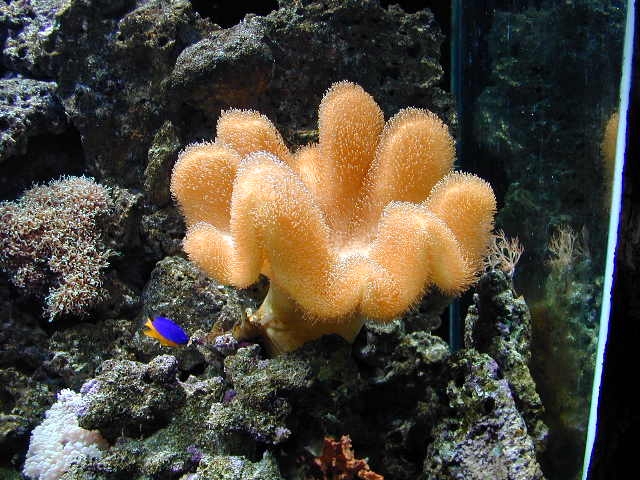zurück
 seeanemone
seeanemone
A sea
anemone is a type of marine animal belonging to the phylum
Cnidaria and the class
Anthozoa, which also includes
corals. These creatures resemble flowers but are actually predatory animals.
They are commonly found in shallow
waters along coastlines, on rocky reefs, or on the seabed. Sea anemones
are famous for their colorful appearance and their symbiotic relationship with
certain species of fish, particularly
clownfish.
Key Features of
Sea Anemones:
-
Appearance:
- Sea anemones are typically
colorful, with hues of
green, red, blue, purple, and orange, but their color can vary depending
on the species and their environment.
- They have a
central mouth
surrounded by tentacles
that are often long and can look like flower petals. The tentacles
contain stinging cells
(called nematocysts)
that are used to capture prey and defend against predators.
- When they are not actively feeding
or defending, sea anemones often
contract and appear as
small, ball-like shapes, but when disturbed, they can extend their
tentacles outward.
-
Habitat:
- Sea anemones are found in
shallow coastal waters,
although some species can live deeper underwater.
- They often attach to hard surfaces
like rocks,
coral reefs, or
the seabed. Some
species can also attach to
other animals, such as shells or even the bodies of
marine invertebrates
like snails or crabs.
-
Diet and Feeding:
- Sea anemones are
carnivorous and
capture their prey using their tentacles. They feed primarily on
small fish,
zooplankton, and
crustaceans.
- When prey comes into contact with
the tentacles, the nematocysts
(stinging cells) release toxins that paralyze or kill the prey. The
anemone then pulls the prey toward its mouth to eat.
- Some species of sea anemones are
filter feeders,
collecting food particles from the water column.
-
Symbiotic Relationships:
- One of the most well-known
relationships involving sea anemones is their partnership with
clownfish. The fish
live among the anemone's tentacles, gaining protection from predators
due to the stinging cells, which do not affect them. In return, the
clownfish provide the anemone with food, such as small prey and
detritus.
- This relationship is an example of
mutualism, where both
species benefit.
- Some species of
crabs and
shrimp also have
similar symbiotic relationships with sea anemones, using them as
protection from predators.
-
Reproduction:
- Sea anemones can reproduce both
sexually and
asexually.
-
Sexual reproduction
involves the release of sperm and eggs into the water, where
fertilization occurs. The resulting larvae settle to form new anemones.
-
Asexual reproduction
occurs through budding,
where a new anemone forms from the body of the parent, eventually
detaching to live independently.
-
Venom and Defense:
- The
nematocysts in their
tentacles release venom to paralyze prey or defend against predators.
While the venom can be harmful or even lethal to small animals and fish,
it usually doesn't pose a significant threat to humans unless a person
is allergic or stung by a large number of tentacles.
- Some species of sea anemones have
developed chemical defenses that deter predators, such as certain
species of fish or sea stars.
-
Longevity:
- Sea anemones are generally
long-lived and can survive for many years. Some species can live for
decades, especially those in more stable, protected environments like
coral reefs.
Notable Species of Sea Anemones:
-
Giant Green Sea Anemone (Anthopleura
xanthogrammica): Found along the Pacific coasts of North America, these
large anemones can grow over 30 centimeters (12 inches) in diameter and are
often green due to symbiotic algae.
-
Bubble Tip Anemone (Entacmaea
quadricolor): This species is commonly kept in
marine aquariums and is
famous for its striking appearance with
brightly colored tips on
its tentacles.
-
Condylactis Anemone (Condylactis
gigantea): Often found in the Caribbean, this species has long, white
tentacles and is known for its attractive appearance.
-
Leather Sea Anemone (Heteractis
crispa): Known for its thick, leathery appearance and often used in the
aquarium trade.
Importance of Sea Anemones:
-
Ecosystem Role: Sea
anemones play an important role in marine ecosystems, especially coral
reefs, by contributing to the biodiversity of these areas. Their stinging
tentacles help control populations of small fish and invertebrates, while
their symbiotic relationships benefit other species.
-
Aquarium Trade: Due to
their vibrant appearance, many species of sea anemones are kept in
marine aquariums, often
in partnership with clownfish.
-
Medicinal Research: Some
sea anemones produce venom that is of interest to scientists studying
potential pharmaceutical
applications, as certain proteins in their venom have shown promise
in pain relief and other treatments.
Interesting Facts:
- Sea anemones are
related to jellyfish and
corals, as they belong to
the same phylum (Cnidaria). Their
stinging cells are a shared feature among these animals.
- The
symbiotic relationship
between clownfish and sea anemones was popularized in the movie
Finding Nemo, which
introduced many to the fascinating interactions between these two species.
Threats and Conservation:
- Like many marine species, sea anemones
face threats from ocean
acidification, climate
change, and overfishing.
Destruction of coral reefs,
which provide a critical habitat for many species, including sea anemones,
is also a growing concern.
 26.07.25 Copyright Dirk
Rauschenbach Koelnerstrasse 293 51702 Bergneustadt
Datenschutzerklaerung 02261 9788972 Mail ccooly(
at) web.de
26.07.25 Copyright Dirk
Rauschenbach Koelnerstrasse 293 51702 Bergneustadt
Datenschutzerklaerung 02261 9788972 Mail ccooly(
at) web.de
 Safaris
Bergsteigen
Wandern
Inselwandern Weltweit
Safaris
Bergsteigen
Wandern
Inselwandern Weltweit
 Europa
Inselwandern
Europa
Inselwandern
 Städtewandern
Städtewandern
 Paintings
Paintings Dirk Rauschenbach
Dirk Rauschenbach
 Safaris
Bergsteigen
Wandern
Inselwandern Weltweit
Safaris
Bergsteigen
Wandern
Inselwandern Weltweit
 Europa
Inselwandern
Europa
Inselwandern
 Städtewandern
Städtewandern
 Paintings
Paintings Dirk Rauschenbach
Dirk Rauschenbach
 seeanemone
seeanemone![]() 26.07.25 Copyright Dirk
Rauschenbach Koelnerstrasse 293 51702 Bergneustadt
Datenschutzerklaerung 02261 9788972 Mail ccooly(
at) web.de
26.07.25 Copyright Dirk
Rauschenbach Koelnerstrasse 293 51702 Bergneustadt
Datenschutzerklaerung 02261 9788972 Mail ccooly(
at) web.de